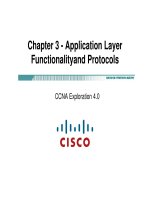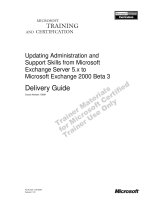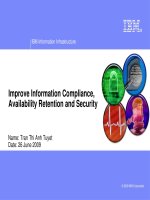Transport and Security Specification Version: 4.3 docx
Bạn đang xem bản rút gọn của tài liệu. Xem và tải ngay bản đầy đủ của tài liệu tại đây (442.39 KB, 13 trang )
12 July 2012
Version: 4.3
Transport and Security Specification
Table of Contents
Overview
3
Bloomberg Access Router …
3
Client Site and Desktop Requirements 4
Network Requirem
ents
5
Capacity and Bandwidth Requirements
5
Source and Destination Ports
5
Network Address Specifications 6
Private Bloomberg Network
6
Internet 6
Additional Network Requirements for Bloomberg over Reliable Internet……
6
Bloomberg Anywhere Non
-
Configured
7
Basic Connectivity Requirements 7
Technical Specifications for the Connection Process 7
Security Features for Bloomberg Anywhere Non-Configured 9
Email Security 10
Socks5 Proxy Server 11
Client to SOCKS5 Proxy Server Communication 11
Virtual Private Network (VPN) 12
Summary Illustration 13
Overview
This document provides network transport and security specifications for the BLOOMBERG
PROFESSIONAL® Service.
Bloomberg Access Router
One or more Bloomberg Access Routers are installed at each Client Site. These routers
provide the following benefits:
Enhanced Data Delivery
The Bloomberg Access Router uses the IP network protocol and addressing scheme along
with a dynamic access
list to deliver data to and from the Bloomberg Private Network.
Seamless Integration
Installing a Bloomberg Access Router requires minimal configuration changes and will not
impact Client Network topology or performance. Bloomberg requires a CAT5 UTP c
able run
from the client hub, router or firewall to distribute data to the Bloomberg workstations.
Security
The Bloomberg Access Router communicates only to the private Bloomberg Network. This is
ensured through dynamic access lists on each Bloomberg Access Router in addition to fixed
virtual circuit path definitions based on the underlying Data-Link protocol SSL.
The Bloomberg Access Router may reside outside Client Site firewalls to further ensure Client Site
LAN integrity.
All connection reque
sts originate from the BLOOMBERG client applications running on the
end-user PC. Bloomberg does not send unsolicited connection requests from outside the
Client Network; thus, connections are initiated from the Client PC to the Bloomberg.
The BLOOMBERG PROFESSIONAL® Software utilizes both UDP and TCP connections and
contains various components and applications such as Bloomberg API, Tradebook, FX and
multimedia that utilize multiple ports.
In the event of a Bloomberg hardware/circuit fai
lure, an alternate path is established on the Host
end to transport Bloomberg data. For locations with multiple Bloomberg routers and E1/T1
circuits, we support RIP v2, VRRP and HSRP for redundancy between routers.
Client Site and Desktop Requirements
This section outlines the desktop requirements to install and run the BLOOMBERG
PROFESSIONAL® Service.
Item
Recommended
Processor
Intel i5 2400 series (Intel i7 900 series preferred)
or AMD Phenom IIX4
Operating System
Microsoft Windows 7 64-bit
Memory:
8 GB RAM
Disk Space:
Minimum 8 GB of free hard disk space
Video Card:
PCI Express (PCIe), Dual port graphics adapter with a minimum of 512MB of memory,
256MB per port
DirectX 10.x compatible
Display Settings
1280x1024x32bit or higher
Network Adapter
Network adapter with TCP/IP Services enabled
Software
Microsoft Office 2007 Service Pack 2
Internet Explorer 8
Audio
Integrated audio adapter
Keyboard
Available USB port to accommodate the Bloomberg Keyboard
Network Requirements
The following section outlines Client Network requirements to access the BLOOMBERG
PROFESSIONAL® Service:
Ethernet network that supports IP
CAT5 UTP cable from the client hub, router or firewall to the Bloomberg Access Router
IP address and subnet mask for the local Ethernet interface on the Bloomberg Access Router
The following table outlines recommended bandw
idth requirements per number of Bloomberg
connections:
(Bloomberg will provide an IP address for clients without an existing IP Address scheme)
Capacity and Bandwidth Requirements
From the Bloomberg Connection Wizard (CONN <GO>) deselect the box
titled “Use specific TCP
port(s)" to allow for toggling between the source port range of 1025-
5000. Selecting this box
restricts the source port range to 8277-8294.
Denotes the Microsoft default ephemeral port range used by Windows 2000 and Windows XP.
Windows Vista
and Windows 7 use a range of 49152-65535.
1
Bloomberg Terminal Network capacity and Bandwidth Requirements
Terminal Count Router Quantity Tail Circuit Bandwidth
1 – 2 1 Up to 2 Mbps
3 - 5 1 Up to 4 Mbps
6 - 9 1 Up to 6 Mbps
10 - 30 2 Up to 10 Mbps
31 – 40 2 Up to 20 Mbps
41 – 50 2
Up to 50 Mbps
51- 100 2 Up to 100 Mbps
100+ 2 Up to 1000 Mbps
• The bandwidth guideline table is based on statistical analysis of network utilization of existing
Bloomberg terminals across the global Bloomberg customer base as well as circuit size offering by
various telecom service providers. Individual customer connectivity and bandwidth capacity
recommendations are made based on continual automated monitoring as well as evaluation by
Bloomberg customer support personnel.
•
For customer sites with 1-9 terminals a single router and circuit with backup through the Internet is
acceptable. All other customer sites are required to have multiple diverse circuits and dual routers.
The bandwidth (bps) recommendations are for a single router. Dual router sites will require double the
stated bandwidth.
TCP Source Ports
TCP Destination Ports
8194 — 8395 and 1024 — 5000
1
8194 — 8198
8194 — 8395 and 1024 — 5000
1
8209 — 8220
8194 — 8395 and 1024 — 5000
1
8290 — 8294
Network Address Specifications
The Client PC can connect to the BLOOMBERG PROFESSIONAL® Service over a private
connection or over the public Internet. The port requirements are the same in both cases;
however, the registered network address ranges of the Bloomberg servers differ.
Private Bloomberg Network
For a private connection, the Client PC must be able to connect to ALL networks in the
following Bloomberg subnets:
The above network prefixes are advertised using RIP v2 from the Ethernet ports of the
Bloomberg Access Routers installed at the Client Site. Alternatively, clients wishing not to
receive RIP can configure their networks to route statically to the above prefixes through the
Ethernet ports of the Bloomberg Access Routers.
Internet
For Internet connections, the Client PC must have Internet connectivity and the ability to
resolve the following DNS names:
Additionally, the Client PC must be able to connect to the following Bloomberg subnets:
Additional Network Requirements for Bloomberg over Reliable Internet
For Bloomberg over Reliable Internet, the Client PC must have Internet connectivity and
the ability to resolve the following domain name and any sub domains:
bloomberg.net (*.bloomberg.net)
Additionally, the Client PC must be able to connect to the following Bloomberg ports on
ANY IP address range:
If the terminal is configured to connect via a SOCKS proxy, then the SOCKS proxy
needs to allow connections to the following domain name and any sub domains:
bloomberg.net (*.bloomberg.net)
208.134.161.0
using the subnet mask of
255.255.255.0
205.183.246.0
using the subnet mask of
255.255.255.0
199.105.176.0
using the subnet mask of
255.255.248.0
199.105.184.0
using the subnet mask of
255.255.254.0
69.184.0.0
using the subnet mask of
255.255.0.0
pdir.bloomberg.net
sdir.bloomberg.net
api1.bloomberg.net
api2.bloomberg.net
api3.bloomberg.net
api3.bloomberg.net
api5.bloomberg.net
api6.bloomberg.net
160.43.250.0
using the subnet mask of
255.255.255.0
206.156.53.0
using the subnet mask of
255.255.255.0
205.216.112.0
using the subnet mask of
255.255.255.0
208.22.56.0
using the subnet mask of
255.255.255.0
208.22.57.0
using the subnet mask of
255.255.255.0
69.191.192.0
using the subnet mask of
255.255.192.0
UDP Destination Port
48129 - 48137
TCP Destination Ports
8194 – 8198
8209 – 8220
8290 – 8294
Bloomberg Anywhere Non-
Configured
BLOOMBERG ANYWHERE allows you to access your Bloomberg login from any desktop or
Internet based terminal, ANYWHERE in the world with the same settings and defaults you have
on your own desktop.
Basic Connectivity Requirements
The following is a list of minimum requirements for Bloomberg Anywhere Non-Configured
running on Intel PCs with Microsoft Operating Systems:
Network Requirements
HTTP Port 80 must be allowed to access any proxy server or firewall
HTTPS Port 443 must be allowed to access any proxy server or firewall
Broadband Internet access or better
Hardware Requirements
Pentium 4 2.0GHz processor or better
Windows XP or better
512MB RAM
20MB of free hard drive space for the installation of Java Web Client, temporary Java files
and temporary Internet files
B-unit for additional authentication to complete the login process
Software Requirements
Internet Explorer 6 with Security set to medium or lower
ActiveX enabled
PC must allow JavaScript, Cookies and pop ups to install the Citrix Client
VeriSign Root certificate installed
Java Platform 1.4.2 or better
Citrix client 11
or Java Client
A customer may choose to install the Citrix Ful
l Program Neighborhood version 8
.0 or better rather
than accepting the download of the Citrix or Java Client. For an administratively disabled PC that
does not allow for the installation of the Citrix Web Client, Bloomberg Anywhere Non-Configured
will utilize Java.
Technical Specifications for the Connection Process
Bloomberg Anywhere Non-Configured uses a Citrix MetaFrame environment to achieve
connectivity to Bloomberg. A Citrix server emulates the user’s mouse movements and keyboard
commands, processes the user’s
interactions locally on the server and “paints” the results back to
the user’s desktop. These servers are on a private Bloomberg network and are not accessible
from the Internet.
To access Bloomberg Anywhere Non-Configured go to
and click the
Bloomberg Anywhere button which initiates an HTTPS connection to
.
A Security Alert dialogue box will inform the user: You are about to view pages over a secure
connection. Any information you exchange with this
site cannot be viewed by anyone else on the
Web.
Click OK to initiate a detection process where the Citrix Web Interface (CWI) used for initial
connectivity attempts to detect which type of Client the user’s PC has and also checks that
service packs and any other updates are correct for a successful connection.
The user is then prompted to enter login credentials, which include login name, password and a
B-Unit screen sync.
Figure 1 Bloomberg Anywhere Login
1. The CWI authenticates the user’s credentials with Bloomberg. If a Citrix Client 7.0 or better is
detected, Bloomberg Anywhere Non-Configured will use this Client to connect. If not, the CWI
will use a Java Client to connect and push the Citrix ICA Web Clie
nt (minimal install) for the next
connection.
2. The Java Client is pushed to the Temporary Internet Files folder on the user’s PC. Therefore,
it is necessary for a user to have full administrative rights to this folder. The first connection will
use the
Java Client and subsequent connections use the Citrix Web Client. Once either of these
processes is completed a session is established at TCP port 443/SSL to a Citrix Secure
Gateway (CSG).
Security Features for Bloomberg Anywhere Non-Configured
Bloomberg’s software and systems architecture are under continuous information and software
security review by a dedicated internal team of software security and information security
personnel. Bloomberg also contracts with outside suppliers and auditors for s
ecurity reviews and
audits. Following are specific security features:
All communication is encrypted and available only through SSL.
Initial connections are to a secure website utilizing a Citrix Web Interface (CWI) product that is
further enhanced, hardened and secured by Bloomberg.
Authentication to the web interface is through Bloomberg User Name, Password and B
-unit.
The BLOOMBERG PROFESSIONAL® is the only application published by the Citrix
environment. This is the same software installed locally on client PCs worldwide.
The Citrix Presentation servers (MetaFrame XP) that run the BLOOMBERG
PROFESSIONAL® are on private IP addresses that are not accessible from the Internet. All
communication to these servers is through the Citrix Secure Gateway using TCP 443/SSL.
In order to take advantage of enhanced security features, the Bloomberg Anywhere
Non-Configured Microsoft environment is entirely Windows Server 2003 based.
Connectivity from the Citrix Presentation Servers and the Bloomberg network are secured
and firewalled in the same manner as all existing configured Bloomberg connections using
private network or Internet. Client side X.509 certificates, SSL based communication and
Bloomberg proprietary session authentication secures this connectivity.
All of the Internet facing DMZs utilize the same infrastructure as existing Bloomberg
Internet facing DMZs. Both firewalls and intrusion detection systems are utilized. These systems
are continuously operated and monitored by two separate teams (one internal and one
outsourced).
User activity logs such as login attempts, source IP addresses, Serial Numbers used and
Citrix Servers used are coupled with existing BLOOMBERG PROFESSIONAL® software logs and
recorded, correlated and processed through use of various management systems. Both
proprietary and vendor specific systems such as Citrix’s CMC and Microsoft
’s IIS logs are utilized.
All traces are removed if bitmap caching is off; however, if bitmap caching happens to be on,
the cache is encrypted (not in plain text).
Citrix’s bitmap caching is disabled server side to ensure that traces of a user's activity
cannot be removed from a remote computer that was used to access the BLOOMBERG
PROFESSIONAL® Service.
Email Security
Bloomberg protects end-user Internet mail data utilizing the following measures:
The Bloomberg proprietary message system transmits Internet email using several
Bloomberg maintained SMTP Gateways. These Gateways also support other messaging
protocols such as X.400, X.500, and SMTP/MIME. All incoming and outgoing email targeted
for the Bloomberg message system must pass and be authenticated through these
Gateways. All users are first authenticated on the Bloomberg Mail Gateways, residing on the
private Bloomberg network.
All data (including mail data) must traverse the Bloomberg Host network before exiting to, or
entering from, the Internet. This Host network employs a Bloomberg proprietary protocol to
send and receive data. Data packets foreign to this protocol format will not be able to enter
the Bloomberg Host Network.
All Internet email traverses Bloomberg’s private network only and is then sent to the
Bloomberg proprietary mail system (MSG<GO>) for user retrieval.
Users accessing a Bloomberg session through the Internet must also traverse and be
authenticated on the Bloomberg SMTP Gateways.
All Internet messages targeted for the Bloomberg message system are scanned for known
viruses before entering the private Bloomberg network. If a virus is found, the infected file is
removed and the intended recipient is notified via an incoming Internet message.
All Bloomberg and Internet messages traversing the Bloomberg private network are stored on
proprietary mail servers thus prohibiting any unauthorized modification of data.
Bloomberg maintains and updates every 24 hours an X.500 directory of all valid users,
including their unique login name and associated Customer and Firm number. All users and
messages are authenticated against this database outside of the Bloomberg Firewall. If a
message does not authenticate against this directory / database, it does not enter the private
Bloomberg network.
Socks5 Proxy Server
For customers utilizing a SOCKS5 Proxy Server, the Client PC will communicate only with the
proxy server and the proxy server will in turn communicate to the Bloomberg servers.
Figure 2 Example of the Client PC to Proxy Server Communication
Client to SOCKS5 Proxy Server Communication
The Client PC will send TCP communication to port 1080 on the SOCKS5 Proxy Server. Upon
initial connection, the Client PC will select the source port for this connection. This destination port
1080 may be different if the proxy server administrator has configured the proxy server to run on a
different port. The communication back from the proxy server to the Client PC will be from port
1080 to the port selected by the Client PC based upon server configuration.
The Client PC will also send UDP communication to the Proxy Server. The source UDP port for
this communication will be 48129, and the proxy server will pick the destination port upon initial
connection. This destination UDP is picked from a range defined by the server administrator. The
communication from the proxy server to the Client PC will be from the port picked by the proxy
server upon initiation to UDP port 48129.
In order for the Bloomberg software to connect with the proxy server, type CONN <GO> within the
Bloomberg application to open the connection box. Under the settings tab, check the box
“Connect through a SOCKS Version 5 Proxy Server” and enter the appropriate DNS or IP
addresses. To allow API/DDE connectivity, click Start Button\Programs\Bloomberg\BBComm
Configuration to open the configuration window. Click the SOCKS5 button and enter the
appropriate DNS or IP addresses.
The communication between the SOCKS5 servers to Bloomberg is the same as defined above for
PC to Bloomberg communication, except the source ports used will be defined and limited by the
server administrator.
Virtual Private Network (VPN)
Customers may choose to use a VPN for traveling users which allows users to connect to the
Client Network using an Internet connection. In order for the application software t
o connect over
a VPN connection, type CONN <GO> within the Bloomberg application to open the connection
box. Under the settings tab, check the “Connect to Bloomberg using a Private IP Network” and
“Use any local IP address” boxes. The VPN server must be configured to forward the network
traffic to the Bloomberg Access Routers. In some cases, the VPN connection must also pass
through a proxy server; therefore, the proxy settings need to be configured as well.
Figure 3 Connection Box (CONN <Go>)
Summary Illustration









